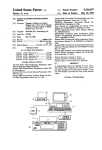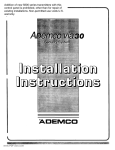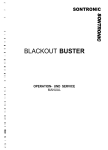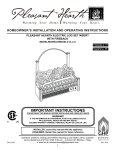Download "a “m
Transcript
United States Patent [191 [11] [45] Shirley, Jr. et al. REPLACEMENT/PROGRAMMING DEVICE Users manual for programming the Mostar NVR (Man ual No. 68P80100W88-O, published in 1985. HT6OO Programmer/Tuner User’s Manual (Manual [75] Inventors: ‘Thomas F. Shirley, Jr., Fort Worth; Jack B. Butler, Bedford, both of Tex. [73] Assignee: Motorola, Inc., Schaumburg, Ill. [21] Appl. No.: 175,361 No. 68P81045C55-2. SMARTNET Standalone Field Programmer Model T5124A (Programming Information Guide 68P-811 l7El1-0, published in 1985. Systems 9000 Conventional Radio Programmer Opera tor’s Manual (Manual No. 68-80309B24-0, published in 1986. Systems 9000 Conventional Control Head Programmer Operator’s Manual, (Manual No. 68-80309B25-O, dated Mar. 30, 1988 [51] Int. Cl.5 ............................................. .. H04B 1/16 [52] US. Cl. .................................. .. 455/186; 455/ 185; [58] Field of Search .... .; ........... .. 455/76, 77, 183, 185, . 455/151 455/186, 151; 364/2219, 222.81, 227.3, 468, May 15, 1986). 919.2 [56] Systems 9000 Trunked Control Head Programmer Op erator’s Manual (Operator’s Manual No. 68-80309B References Cited 26-0, dated May 15, 1986. U.S. PATENT DOCUMENTS 4,525,865 6/1985 4,688,261 8/1987 Killoway et a1. 4/1988 455/186 Soderberg et al. .... .. 4,771,399 9/1988 Snowden et al. 4,792,986 12/1988 “The up: The Key to an Advanced Frequency Synthe sized HF SSB Amateur Radio Transceiver”; IEE Transactions on Consumer Electronics; vol. CE-26; Mears ................................ .. 455/186 4,739,486 May 28, 1991 EEPROM Programmer (Instruction Manual No. 68PO6088T60-0, published in 1984. [54] RADIO COMPONENT [22] Filed: 5,020,144 Patent Number: Date of Patent: 364/464 Aug. 1980; pp. 234-246, class 455/76. Primary Examiner-Douglas W. Olms Assistant Examiner-Ralph Smith 455/186 Garner et al. ..................... .. 455/186 OTHER PUBLICATIONS Attorney, Agent, or Firm-Steven G. Parmelee The MC Micro Field Programmer Handbook, dated 1985 by Motorola Gmbl-I Taunusstein. Systems 9000 Trunked Radio Programmer, dated 1986 [57] ABSTRACT A programming station for use in programming and servicing two-way radios that include replaceable hard ware elements. Both user-only and programming sta tion-assisted steps are simultaneously displayed in a predetermined order. The steps may only be accom by Motorola, Inc. Systems 9000 Conventional Options Programmer, dated 1985, Motorola, Inc. Systems 9000 Conventional 64 Mode Radio and Con trol Head Programmer, dated Nov. 12, 1985. Systems 9000 Conventional 32 Mode Radio and Con trol Head Programmer, dated Nov. 12, 1985. plished in a fixed. allowed order. 16 Claims, 7 Drawing Sheets 18 19 ‘PRINTER 16 / "a llllllllllllll RIB “m . 1a " ._ 12 + P0 FER - SOURCE‘ 11 l EL 11111111] VOLUME 12mm] L___] [313G] [BEBE] [DEJE] 17 US. Patent May 28, 1991 Sheet 1 of 7 5,020,144 D I8 40 19 o O PRINTER / 14\\ I IIIIIIIIIIIEI RIB 13 I6 [I g u‘ 17 I‘ 3< 12 +- SOURCE POWER , 11 L [jumps mmumcnan%%% DJ 1mm VOLUME 19 [E91 [M113 FIG. 1 FIG.2 1/ 21 20 ._ / 23 7 ' 7 3 1 82 1/ 22 lsascFFiucnon m F1-F10. ' w I MAIN MENU - HELP - SERVICE: ALIGNMENT, SERVICE AIDS AND BOARD REPLACEMENTS G ET SAVE PROGRAM CODEPLUG DATA FROMRO DISK/CODEPLUC CHANGE/VIEW CREATE RADIO CODEPLUG PRINT CODEP UC DATA 1 - SETUP CGIPUTER CONFIGURATION F10- EXIT RADIO SERVICE SOFTWAREl RETURN TO DOS F1 F2 F3 F4 F5 F6 F7 F8 F9 HELP SERVICE SAVE GET CHANGE PRINT VIEW ( F10 SETUP TOEXIT DOS L(1D 1987 MOTOROLA, INC. J 24 US. Patent May 28, 1991 Sheet 2 of 7 m..UFW 5,020,144 US. Patent May 28, 1991 Sheet 4 of 7 5,020,144 FIG. 4 21 f 32 1/ __ FsPEcrRA' MODEL: omewaw 1/ 22 /23 sum ruucnou KEY FI-FIO. ’ /S sm 7 1 _ [:l SERVICE MENU 1 F1 - HELP F'Z — AUGNNIENT: TRANSMITTER AND RECEIVER g — ADVANCED ALIGNMENT PROCEDURES FOR BOARD REPAIR ONLY ‘I?’ — BOARD REPLACEMENT PROCEDURES F8 — SERVICE AIDS RID TROUBLE SHOOTING AIDS F9 - m- EXIT/RETURN TO MAIN MENu FI F2 F3 F4 F5 F6 F7 HEIP ALIGNMENT ADVANCED BOARD F8 F9 SERVICE ALIGNMENT REPLACEMENT / LL F10 EXIT AIDS (3) 1987 MOTOROLA, INC. J 24 . 1/ 21 5g 23 _ / 22 GsPEcmA sRvcA- REPAIR I MODEI.‘ D37KGA5JB9AK IsELEcr 7 FUNCTION KEY FI-FIII ' BOARD REPLACEMENT / REPAIR MENU F1 - HELP /1 7 [:l / ' F3 - coMMAND m0 AND OR MICROPROCESSOR REPAIR / REPLACEMENT g - MEMORY BOARD REPIA EMENT F6 - POWER AMPunER REPAIR REPLACEMENT Fl-RFBOARDREPAIR/REP EMENT F8 _ F9 — VCO BOARD REPAIR REPLACEMENT FID- EXIT / RETIRN TO ERVICE MENU HELP COMMAND MEMORY BOARD BOARD PA RF BOARD BOARD L© 1987 MOTOROLA, INC. vco EXIT soARo J \ 24 ©©©k US. Patent May 28, 1991 Sheet 6 of 7 5,020,144 FIG.9 ,2: / 22 frwm Wham ‘m m u. m m um n 2m m." mwm "mm Mm @mmm WWmo 5. mm W mm W W... mmmm WWW Hmmm. HW. 1% mm nmmm wwm swam mmw mmmm W m. W PW m D7T [QHH 1.234.:1.1 n HSmr .MRC1.-HERFM2 mm Mmnm aum wG11km?/l\\m m W m D. .FF.. E mm 0 Lm W H W m m H M . /2/7 2y J /U©E© W MWSPBW u\. j US. Patent May 28, 1991 Sheet 7 of 7 5,020,144 FIG. 1 1 23 1/ 21 / 22 OSPECTRA ' noon.- osvxcmaw lsascr ruucnou m n-Fw ' save REPAIR: vco so vco mo REPLACEMENT PROCEDURE WE+ 7i F2 cow scr F5 DEV sEr F4 F5 F6 F7 F8 / F9 ice) 1987 MOTOROLA, mc. F10 cxn J \ - If i [I] REPLACE VCO BOARD PER SERVICE MANUAL PRESS F2 T0 AUGN VCO COMPENSKTION QAUBRATION. PRES F3 TO AUGN V00 DEVIATION. BOPRD REPlACEMENT PROCEDURE l5 COMPLETE PRESS F10 TWICE TO RETURN TO SERVICE MENU. r1 new k’ / 5,020,144 1 2 BRIEF DESCRIPTION OF THE DRAWINGS FIG. 1 comprises a block diagram depiction of the RADIO COMPONENT REPLACEMENT/PROGRAMMING DEVICE invention as coupled to a two-way radio; FIG. 2 comprises a depiction of a main menu as pres MICROFICHE APPENDIX This speci?cation includes a micro?che appendix comprising 7 micro?che and 643 frames. ented at the programming station; FIG. 3 comprises a diagrammatic representation of the functional capabilities of the programming station; FIG. 4 comprises a depiction of a service menu as COPYRIGHT INFORMATION 10 presented at the programming station; A portion of the disclosure of this patent document FIG. 5 comprises a diagrammatic representation of contains material that is subject to copyright protection. the functional capabilities available at the programming The copyright owner has no objection to the facsimile reproduction by anyone of the patent document or the patent disclosure, as it appears in the Patent and Trade mark Of?ce patent file or records, but otherwise re serves all copyright'rights whatsoever. station from the service menu; FIG. 6 comprises a depiction of a board replacement /repair menu as presented at the programming station; FIG. 7 comprises a depiction of a command board or microprocessor replacement procedure menu as pres ented at the programming station; TECHNICAL FIELD FIG. 8 comprises a depiction of a memory board This invention relates generally to the programming 20 replacement procedure menu as presented at the pro and servicing of two-way radios. gramming station; FIG. 9 comprises a power ampli?er replacement BACKGROUND ART procedure menu as presented at the programming sta Two-way radios are becoming increasingly sophisti tion; cated. Many such radios now realize many operating functions and features through provision of an on-board microprocessor. For example, some models of the Spec tra land mobile radio, manufactured by Motorola, Inc., do not include any internal adjustable components such as potentiometers or coils. Instead, all RF and signalling parameters are controlled by an on-board microproces FIG. 10 comprises an RF board replacement proce dure menu as presented at the programming station; and FIG. 11 comprises a VCO board replacement proce dure menu as presented at the programming station. BEST MODE FOR CARRYING OUT THE INVENTION Referring now to FIG. 1, the programming station, sor. These increasingly sophisticated radios have given depicted generally by the numeral 10, operates in con junction with an appropriate two-way radio (11). The rise to a concurrent need for a similarly sophisticated means of servicing the radio, particularly in conjunction 35 radio (11) connects to an appropriate power source (12) with the replacement of hardware elements in the radio. and the programming station (10) couples to the radio (11) through an appropriate coupling mechanism; in this SUMMARY OF THE INVENTION case, a radio interface box (13). Each of these compo These and other needs are substantially met through provision of the radio component replacement/pro gramming device disclosed herein. nents will now be described in more detail in seriatim 40 fashion. The radio (11) may be, for example, a Spectra brand This device is intended for use with two-way radios two-way land mobile radio as manufactured and sold by that have a memory for storing at least some radio con Motorola, Inc. Such a radio has an internal micro trol parameters, an internal computer for controlling at processor for controlling its radio control functions. (As least some radio control functions in response to the 45 used herein, “radio control functions” refers to radio stored parameters, and at least one replaceable hard speci?c performance parameters, such as deviation, ware element that supports operation of the radio. The device includes an appropriate coupling mecha reference oscillator, transmit power, signalling devia tion, and so forth.) nism to allow access to at least the memory in the radio, This radio has many of its hardware elements ar and a programming station for communicating with the 50 ranged on replaceable boards. For example, any of the radio via the coupling mechanism. The programming command board (which includes the microprocessor), the memory board, the power ampli?er board, the RF station allows an operator to access the memory and write radio control parameters thereto. More particu board, and the VCO board can be replaced as a unit larly, the programming station stores radio control pa during servicing. Replacement of such boards, how rameters in the radio’s memory in a particular prede 55 ever, generally requires some reprogramming of the ?ned order, subsequent to replacing a replaceable hard radio to ensure the proper functioning of the radio with ware element. the new board. . In one embodiment, the programming station inhibits The microprocessor in the radio communicates with an attempt to store parameters in the radio’s memory other devices within the radio and external to the radio on a serial bus. The radio interface box (13) functions to level shift the RS232 voltage level signals that are out put and received by the programming station (10) to an unless the radio is both coupled to the programming station and the radio is switched on. In another embodiment of the invention, the pro appropriate signal level that is compatible with the gramming station displays all relevant steps that relate radio’s serial bus interface. to a particular hardware element replacement process, including both operator-only and programming station assisted steps. Although these steps are displayed simul taneously, the programming station will only allow the steps to be processed in a particular prede?ned order. 65 The radio interface box (13) may be provided through use of Part No. 0l-80353A74. The cable be tween the radio interface box (13) and the radio (11) may be provided through use of Part No. 30-80369B73. 3 5,020,144 4 . and print (36). (Additional information regarding the service function (32), the get/save functions (33) and The cable between the radio interface box (13) and the programming station (10) may be provided through use the print function (36) can be found in copending US. patent application Ser. No. 175,084, ?led on Mar. 30, l988 and entitled Radio Programming Device, Ser. No. 175,003, ?led Mar. 30, 1988 and entitled Radio Align ment/Programming Device, and Ser. No. 175,002, ?led on Mar. 30, 1988 and entitled Radio Programming De vice With Access To A Remote Database, which appli cations are incorporated herein by this reference.) In general, the service function (32) comprises a mul tilevel menu routine that supports radio alignment, ad vanced alignment, board replacement, and service aids of a Part No. 30-80369B7l. All of the above noted parts are manufactured and sold by Motorola, Inc. The programming station (10) can be comprised of an IBM personal computer or compatible (14), which in cludes at least one RS232 port, 512K RAM, and a DOS 3.0 operating system. In addition, at least one disk drive (16), a keyboard (17), a display screen for displaying alphanumeric information (18) and a printer (19) should be provided. A micro?che appendix of a software program is in cluded with this speci?cation. With this program functions. All service screens access the memory in the loaded in the programming station (10), the program 15 radio directly, and it is not necessary to read the radio’s ming station (10) will function as described below. memory via the get/save function (33) before using the Referring now to FIG. 2, most actions of the pro service screens. All service .screens use the same four gramming station (10) are controlled through the use of dedicated screen sections described earlier. formatted screen displays and the function keys ordinar The get/save function (33) generally functions to ily found on the keyboard (17) (i.e., F1-F10). In gen eral, all screens provided at the programming station 20 read radio control and radio feature parameters as (10) use an identical format, with the screen being di vided into four dedicated sections. The ?rst dedicated section comprises a box (21) in the upper left hand cor ner of the display screen. This box (21) displays the radio’s trademark (in this case, “Spectra”) or other 25 desired indicia, along with the model number (or other stored in a radio’s memory, and to obtain archived pa rameter information from a diskette or hard disk. How ever obtained, the change/ view function (34) can then be used to edit the parameter information. The get/save function (33) also operates to write modi?ed parameter information into the radio’s memory, or to save the modi?ed parameters to an archive ?le on a diskette or radio type indicia) of the radio as read from the radio’s memory (the model number is not displayed in FIG. 2 hard disk. Finally, the print function (36) allows production but can be seen in FIG. 4). The second dedicated section comprises a box in the 30 permanent records of parameter con?gurations. of Referring now to FIG. 4, the service function (32) upper right hand corner (22) that displays an indication of a generic type of input that the programming station will be described in more detail. (10) expects at that time from the user. For example, as depicted in FIG. 2, the words “Select Function Key dures are accessed from the service menu (32). A radio Fl-FIO” instruct the operator that one of the indicated function keys must be actuated to select a desired opera must be connected to the programming station (10) and the radio must be active before the programming station All radio alignment and board replacement proce tion. Also, error messages and data entry errors are (10) will allow a user to access the service menu (32). displayed in this box (22) when necessary. The third dedicated section comprises a large center box (23) that contains menu descriptions or data entry Also, all service screens read and program the radio’s memory directly. The user does not need the get/save functions (33) to use the service features. ?elds, depending upon the function currently in From the service menu (32), a user can select function key F1 for help. Function key F2 can be selected to progress. FIG. 2 displays the main menu in this section initiate the alignment functions. With reference to FIG. (23). The main menu indicates the other functions that can be accessed through use of the function keys. 5, the alignment function (37) allows adjustment of Finally, the fourth dedicated section comprises an 45 default squelch, transmitter VCO deviation, reference oscillator warp, transmitter power set (both high and area at the bottom (24) of the screen. This section (24) provides an abbreviated indication of each function key low) and transmitter current limit. With reference to both FIGS. 4 and 5, function key operation. In general, the location of this display indicia F4 can be selected to initiate certain advanced align coincides with the general location of the function keys themselves as an additional aid to the operator. 50 ment functions (38). These include transmitter VCO With reference to FIG. 3, the programming station (10) provides screens and functions organized as de compensation adjustment, transmitter VCO compensa tion calibration, and signalling deviation adjustments as picted. The system will not allow an operator to ran domly jump from one screen or function to another. Instead, the operator must move up and down the may be relevant. Function key F6 initiates the board replacement func tion (39). This function allows servicing of the radio when a board repair and/or replacement is necessary. branches by using the menu screens and function keys in an appropriate manner. For example, pushing the F1 function key will provide a help function (26) which in turn leads to various other help options, including “more help” (27) and “keyboard help” (28). The help options provide helpful supplemental information re garding the operation of the programming station (10) 60 Special initialization procedures and step by step in structions are given for all realignment procedures when replacing or servicing the command board, the memory board, ~the power ampli?er board, the RF board, or the VCO board. More detail regarding the board replacement functions (39) will be provided be low. Finally, the F8 function key initiates a service aids In addition to the help function (26), the main menu (20) provides access to an initial setup function (29) and 65 function (41) that interacts with special test capabilities that may be designed into the radio itself. an exit routine (31). The main menu (20) also allows Selection of the F6 function key from the service access to four important service and programming menu (32) will initiate the board replacement function menus: service (32), get/save (33), change/view (34), to the user. 5 5,020,144 (39) as mentioned earlier. With reference to FIG. 6, this allows presentation at the programming station (10) of the board replacement/repair menu screen as depicted. From this menu, the user can select proper program ming procedures that relate to replacement or repair of the command board (or microprocessor) (function key F3), replacement of the memory board (function key F4), repair or replacement of the power ampli?er (func tion key F6), repair or replacement of the RF board (function key F7), and repair or replacement of the VCO board (function key F9). Step by step instructions 6 then required to select the enter key to enable the next function. Selection of function key F2 serves to initialize the new memory board. Once this function has been accom plished, it then becomes necessary to program that memory with all relevant radio control parameters. Since the programming station (10) provides the capa bility to store an archive copy of all radio control pa rameters of all radios that it has programmed, and since the memory board replacement procedure presupposes are provided to the user for all realignment procedures when replacing or servicing the above noted hardware elements of the radio. In addition, each procedure, that the radio has been previously programmed but now needs a new memory board, the procedure provides, as step 4, the opportunity to proceed to the get/save func tion (33) to allow restoration of the previously stored though simultaneously fully displayed, allows execution information to the radio. Otherwise, the user can exit to only in a top to bottom order to ensure proper ?nal the service menu by selecting the F10 function key twice, or choose the change/view function (34) to ei calibration. Referring now to FIG. 7, the command board re ther obtain new data for conventional radios or trunk ing data for trunked radios via the TCMS capabilities of placement procedure will be described. Replacing the command board and/or microproces 20 the change/view function (34). All of the above options sor will require that the microprocessor be initialized and that the radio be completely realigned. This board replacement function performs both tasks. Before this alignment process can be initiated, however, the com mand board/microprocessor must ?rst be replaced. are displayed on the screen and assist in guiding the user station (10) allows a user to attempt to initialize and/or set) through sequential selection of function keys F2 to a correct selection. Referring now to FIG. 9, the power ampli?er re placement procedure as selected through the board replacement/repair menu (39) will be described. As required earlier, this procedure also requires as This constitutes a user-only step that cannot be accom step 1 the replacement of the PA board itself. The user plished through use of the programming station. Never indicates completion of this step by selection of the theless, the programming station (10), in step 1, does instruct the operator to replace the command board/ 30 enter key. The user then selects the appropriate align ment procedures (alignment of the PA high power set microprocessor as per the instructions in the relevant and current limit, and alignment of the PA low power service manual. Therefore, before the programming align the radio, the user is reminded that the hardware elements in question must be replaced ?rst. When the hardware elements as indicated have been replaced, the user then selects the enter key on his key board (17) to indicate completion of step 1 and to enable the next step. Again, only the function key for the cur rently allowable step will be enabled. The user is there fore restricted to a correct predetermined sequence of steps. Prior to initializing the microprocessor or realigning the radio, of course, the user must also have the proper and usual alignment equipment appropriately con nected to the radio. Also, once the alignment sequence has been initiated, all of the steps indicated at the pro gramming station (10) must be completed in the hidi and F3, in that order. No other alignment procedures 35 are then required, and the user can return to the service menu (32) by selecting the F10 function key twice. Referring now to FIG. 10, the RF board replacement procedure as selected through the board replacement /repair menu (39) will be described. Step 1, requiring replacement of the RF board, can be indicated by the user through selection of the enter key. The user then initiates and completes alignment of the reference oscillator, VCO compensation, and VCO deviation through selection of function keys F2, F3, and 45 F4, in that order. The user can then return to the service menu (32) by twice selecting the F10 function key. Lastly, with reference to FIG. 11, VCO board re placement procedure as selected from the board re placement/repair menu (39) will now be described. cated sequence. By next selecting function key F2, the user can initial 50 Following replacement of the VCO board and indica tion of same through the enter key, the user can adjust ize the microprocessor in the radio. When this has been completed, the alignment process can begin by selection of function key F3. Following that, and in sequence, function keys F4-F8 are initiated in turn to accomplish alignment of the reference oscillator, alignment of the PA high power set and current limit, alignment of the PA low power set, alignment of VCO compensation calibration, alignment of VCO deviation, and alignment of signalling deviation. When the alignment process has been completed, the operator may return to the service menu (32) by press VCO compensation calibration and VCO deviation by selecting function keys F2 and F3 in that order. The service menu (32) can then be selected by twice select ing the F10 function key. ‘ Through use of this programming station (10), initial ization of appropriate components and realignment of the radio can be accomplished following repair or re placement of various hardware elements in the radio. The alignment steps and other user and device assisted steps are presented in a predetermined fashion to ensure proper calibration of the radio, and execution of the steps is allowed in only this predetermined manner. Referring now to FIG. 8, the memory board replace We claim: ment procedure as accessed through the board re 1. A device for programming a radio, which radio 65 placement/repair menu (39) will be described. includes: Again, this process presupposes that a memory board at least one replaceable hardware element that sup is being replaced in accordance with the instructions in ing function key F10 twice. the service manual as indicated in step 1. The user is ports operation of said radio; 5,020,144 7 8 B) displaying, in a predetermined order, a plurality of programming station-assisted procedures for memory means for storing at least some radio control parameters; programming at least some of said radio control ‘ computer means for controlling at least some radio control functions in response to said radio control A) coupling means for coupling to said memory parameters, wherein said plurality of program ming station-assisted procedures are displayed in a predetermined order; C) enabling only one of said displayed procedures means; and B) means for connecting to said coupling means at a time to allow its selective implementation. 9. The method of claim 8 wherein said plurality of parameters; said device comprising: (II and for storing said radio control parameters in programming station-assisted procedures are displayed said memory means in a particular prede?ned simultaneously. order when programming said radio subsequent 10. The method of claim 8 wherein step B includes the step of: displaying user-only procedures that relate to re placement of said hardware element, such that said to replacing said at least one replaceable hard ware element wherein said means includes: i) input means for receiving input from an opera tor; and plurality of programming station-assisted proce - dures and said user-onlyprocedures are displayed in a predetermined order. ii) display means for displaying both operator only and device-assisted steps for replacing 11. A method of changing a hardware element in a said replaceable hardware element. 2. The device of claim 1 wherein said means includes 20 radio and aligning said radio, wherein said radio in cludes: inhibit means for inhibiting access to storing said radio at least one replaceable hardware element that sup control parameters in said memory means in a particular ports operation of said radio; prede?ned order except when said means is connected to said coupling means and said coupling means is cou 25 pled to said memory means. 3. The device of claim 2 wherein said inhibit means will also inhibit access to storing said radio control parameters; computer means for controlling at least some radio control functions in response to said radio control parameters; parameters in said memory means in a particular prede ?ned order when said radio is switched off. 4. The device of claim 1 wherein said means further includes key means for causing said radio to transmit. 5. The device of claim 4 wherein said key means includes timer means for causing said radio to cease the method comprising the steps of: A) providing a programming station having a dis play and an input device, which programming station communicates with at least said memory means to allow said radio control parameters to be programmed by said programming station; transmitting after a predetermined period of time. 6. The device of claim 1 wherein: memory means for storing at least some radio control 35 B) displaying, on a display: user-only procedures that relate to replacement of said hardware element; A) said display means simultaneously displays all of said operator-only and device-assisted steps for replacing a particular replaceable hardware ele a plurality of programming station-assisted pro cedures for programming at least some of said ment; and B) said means only accepts input with respect to a predetermined one of said steps in accordance with radio control parameters; wherein said user-only procedures and said plurality said particular prede?ned order. 7. The device of claim 6 wherein each of said steps must be individually initiated by a user of said means. 8. A method of changing a hardware element in a 45 of programming station-assisted procedures are displayed in a predetermined order; C) enabling only one of said displayed procedures at a time to allow selective implementation of only that enabled procedure. radio and aligning said radio, wherein said radio in cludes: 12. The method of claim 11 wherein said selective implementation is implemented by a user of said pro at least one replaceable hardware element that sup gramming station through said input device. ports operation of said radio; 13. The method of claim 12 wherein said input device memory means for storing at least some radio control is a keyboard. 14. The method of claim 11 wherein said procedures are singularly enabled in a predetermined order. parameters; and computer means for controlling at least some radio control functions in response to said radio control 15. The method of claim 14 wherein said predeter parameters; 55 mined order for enabling said procedures and said pre the method comprising the steps of: determined order for displaying said procedures are A) providing a programming station having a dis identical. play and an input device, which programming 16. The method of claim 11 wherein said procedures station communicates with at least said memory are displayed simultaneously. means to allow said radio control parameters to be programmed by said programming station; 60 65 # i it # i






















